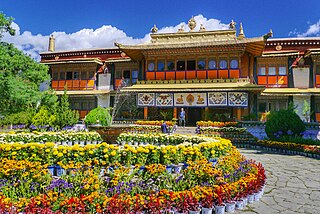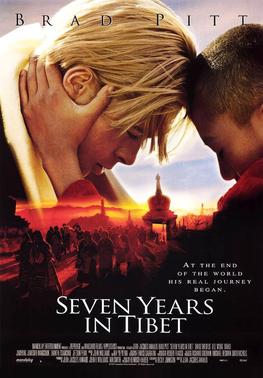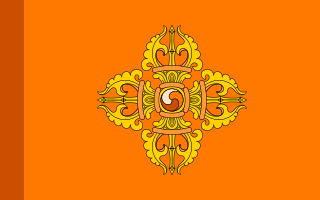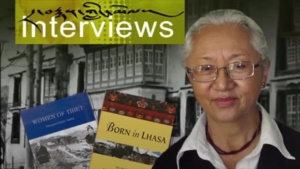Related Research Articles

Dalai Lama is a title given by Altan Khan, the first Shunyi King of Ming China, in A.D. 1578 at Yanghua Monastery to the foremost spiritual leader of the Gelug or "Yellow Hat" school of Tibetan Buddhism, the newest and most dominant of the four major schools of Tibetan Buddhism. The 14th and incumbent Dalai Lama is Tenzin Gyatso, who lives in exile as a refugee in India. The Dalai Lama is considered to be the successor in a line of tulkus who are believed to be incarnations of Avalokiteśvara, the Bodhisattva of Compassion.

Lhasa, officially the Chengguan District of Lhasa City, is the inner urban district of Lhasa City, Tibet Autonomous Region, Southwestern China.

While the Tibetan plateau has been inhabited since pre-historic times, most of Tibet's history went unrecorded until the creation of Tibetan script in the 7th century. Tibetan texts refer to the kingdom of Zhangzhung as the precursor of later Tibetan kingdoms and the originators of the Bon religion. While mythical accounts of early rulers of the Yarlung Dynasty exist, historical accounts begin with the introduction of Tibetan script from the unified Tibetan Empire in the 7th century. Following the dissolution of the empire and a period of fragmentation in the 9th-10th centuries, a Buddhist revival in the 10th–12th centuries saw the development of three of the four major schools of Tibetan Buddhism.

The music of Tibet reflects the cultural heritage of the trans-Himalayan region centered in Tibet, but also known wherever ethnic Tibetan groups are found in Nepal, Bhutan, India and further abroad. The religious music of Tibet reflects the profound influence of Tibetan Buddhism on the culture.

The 13th Dalai Lama, Thubten Gyatso was the 13th Dalai Lama of Tibet, enthroned during a turbulent modern era. He presided during the Collapse of the Qing Dynasty, and is referred to as "the Great Thirteenth", responsible for redeclaring Tibet's national independence, and for his national reform and modernization initiatives.

Lobsang Trinley Lhündrub Chökyi Gyaltsen was the tenth Panchen Lama, officially the 10th Panchen Erdeni, of the Gelug school of Tibetan Buddhism. According to Tibetan Buddhism, Panchen Lamas are living emanations of the buddha Amitabha. He was often referred to simply as Choekyi Gyaltsen.

Norbulingka is a palace and surrounding park in Lhasa, Tibet, built from 1755. It served as the traditional summer residence of the successive Dalai Lamas from the 1780s up until the 14th Dalai Lama's exile in 1959. Part of the "Historic Ensemble of the Potala Palace", Norbulingka is recognized as a UNESCO World Heritage Site, and was added as an extension of this Historic Ensemble in 2001. It was built by the 7th Dalai Lama and served both as administrative centre and religious centre. It is a unique representation of Tibetan palace architecture.

Tibet developed a distinct culture due to its geographic and climatic conditions. While influenced by neighboring cultures from China, India, and Nepal, the Himalayan region's remoteness and inaccessibility have preserved distinct local influences, and stimulated the development of its distinct culture.

Monlam, also known as The Great Prayer Festival, falls on the 4th to 11th day of the 1st Tibetan month in Tibetan Buddhism.
Tibetology refers to the study of things related to Tibet, including its history, religion, language, culture, politics and the collection of Tibetan articles of historical, cultural and religious significance. The last may mean a collection of Tibetan statues, shrines, Buddhist icons and holy scripts, Thangka embroideries, paintings and tapestries, jewellery, masks and other objects of fine Tibetan art and craftsmanship.
Rangzen Shonu was a three-member rock band formed by Tenzin Choesang, Norbu Choephel and Tsering Paljor Phurpatsang. Tibetans in Dharamshala, India.

Seven Years in Tibet is a 1997 American biographical war drama film directed by Jean-Jacques Annaud. It is based on Austrian mountaineer and Schutzstaffel (SS) sergeant Heinrich Harrer's 1952 memoir of the same name, about his experiences in Tibet between 1944 and 1951. Seven Years in Tibet stars Brad Pitt and David Thewlis, and has music composed by John Williams with a feature performance by cellist Yo-Yo Ma.

Thubten Jigme Norbu, recognised as the Taktser Rinpoche, was a Tibetan lama, writer, civil rights activist and professor of Tibetan studies and was the eldest brother of the 14th Dalai Lama, Tenzin Gyatso. He was one of the first high-profile Tibetans to go into exile and was the first to settle in the United States.

The 1959 Tibetan uprising began on 10 March 1959, when a revolt erupted in Lhasa, the capital of Tibet, which had been under the effective control of the People's Republic of China (PRC) since the Seventeen Point Agreement was reached in 1951. The initial uprising occurred amid general Chinese-Tibetan tensions and a context of confusion, because Tibetan protesters feared that the Chinese government might arrest the 14th Dalai Lama. The protests were also fueled by anti-Chinese sentiment and separatism. At first, the uprising mostly consisted of peaceful protests, but clashes quickly erupted and the Chinese People's Liberation Army (PLA) eventually used force to quell the protests. Some of the protesters had captured arms. The last stages of the uprising included heavy fighting, with high civilian and military losses. The 14th Dalai Lama escaped from Lhasa, while the city was fully retaken by Chinese security forces on 23 March 1959. Thousands of Tibetans were killed during the 1959 uprising, but the exact number of deaths is disputed.
Marie Louville, is a French journalist, an expert on Tibet, and a director of documentary films on Tibet.
Phuntsog Nyidron is a Tibetan Buddhist nun and a former high-profile prisoner in Tibet. In 1989, she and eight other nuns traveled from her hometown to the provincial capital of Lhasa when it was convulsed by Tibetan independence protests and riots, and handed out leaflets and shouted anti-Chinese slogans. She was tried and imprisoned for the charge of counterrevolutionary propaganda and incitement and imprisoned at the Drapchi Prison that same year. During her incarceration, she produced and smuggled out tapes of her and other prisoners' political songs, engaged in hunger strikes, and made publicized allegations of mistreatment. One of the better-known Tibetan prisoners outside Tibet, she was the subject of a release campaign by several United States Congress parliamentarians and governmental groups. Because of their efforts, and Chinese wishes to improve Sino-American relations, her sentence was reduced and commuted in 2004. She lives in Switzerland since 2006.
The 1987–1989 Tibetan unrest was a series of protests and demonstrations that called for Tibetan independence. These protests took place between September 1987 and March 1989 in the Tibet Autonomous Region, in the Tibetan regions of Sichuan, and Qinghai, as well as the Tibetan prefectures in Yunnan and Gansu. Protests began shortly after the Dalai Lama, the religious and temporal leader of Tibet exiled in India since the 1959 Tibetan unrest, proposed a Five Point Peace Plan regarding the “status of Tibet” on September 21, 1987, which was subsequently rejected by the Chinese government. The Plan advocated for greater respect and autonomy of the Tibetan people, and claimed that “Tibet was a fully independent state when the People’s Liberation Army invaded the country in 1949-50.” China rejected the idea of Tibetans as an invaded people, stating that “Tibet is an inalienable part of Chinese territory” and has been for hundreds of years. The Tibetan sovereignty debate is longstanding, and the Tibetan assertion that they are a separate and unique people invaded by China has become a central argument for their independence.

The Tibetan Army was the armed forces of Tibet from 1913 to 1959. It was established by the 13th Dalai Lama shortly after he proclaimed the independence of Tibet in 1912, and was modernised with the assistance of British training and equipment. It was dissolved by the Chinese government following the failed 1959 Tibetan uprising.

Robert Barnett is a Professorial Research Associate at SOAS, University of London and Affiliate Lecturer and Research Affiliate at the Lau China Institute, King's College, London. He is the former Director of the Modern Tibetan Studies Program, where he was Adjunct Professor of Contemporary Tibetan Studies and Senior Research Scholar in modern Tibetan history at the Weatherhead East Asian Institute at Columbia University. He retired from Columbia as of January 2018. He is also referred to as Robbie Barnett by the media.

Namgyal Lhamo Taklha is a member of the Tibetan community living in exile. Between 1988 and 1994 she was elected to the Parliament of the Central Tibetan Administration and held the post of Health Secretary in the Central Tibetan Administration Cabinet based in India.
References
- ↑ Robert Barnett, Ronald D. Schwartz, Proceedings of the Tenth Seminar of the IATS, 2003. Volume 11: Tibetan Modernities: Notes from the Field on Cultural and Social Change, BRILL, 2008, ISBN 9004155228, p. 292
- ↑ Performances Archived 2015-06-15 at the Wayback Machine , Trinity College
- ↑ (in English) Janet Gyatso, Women in Tibet
- ↑ (in English) Phinjo Gombu, A 966-km march to save tibet. dalai lama's brother among 12 headed for new york Archived 2015-09-24 at the Wayback Machine , Toronto Star , 10 March 1997
- ↑ (in English) Tibet Information Network, Unity and discord: music and politics in contemporary Tibet, 2004, p. 83- 84 Dadon is Tibet's first pop star, and remains one of the most successful to this day.... She was inspired by the Taiwanese singer Deng Lijun, known as Teresa Teng, and emulated her singing style. However, as Henrion-Dourcy reports, another point of inspiration was Modern Tibetan songs, the 1995 cassette of the Dharamsala-based band Rangzen Shonu, 'Freedom Youth', which was smuggled into Lhasa in 1988.
- ↑ (in English) Robert J. Barnett, Beyond the collaborator-martyr model, in Contemporary Tibet: Politics, Development, and Society in a Disputed Region, Barry Sautman and June Teufel Dreyer, see p. 45 and note 66, p. 60
- ↑ (in English) Phinjo Gombu, A 966-km march to save tibet. dalai lama's brother among 12 headed for new york Archived 2015-09-24 at the Wayback Machine , Toronto Star , 10 March 1997
- ↑ Robert Barnett, Ronald D. Schwartz, Proceedings of the Tenth Seminar of the IATS, 2003. Volume 11: Tibetan Modernities: Notes from the Field on Cultural and Social Change, BRILL, 2008, ISBN 9004155228, p. 292
- ↑ (in English) Ty Burr, Vajra Sky Over Tibet' presents beautiful scenes and a dark side, The Boston Globe , 18 August 2006